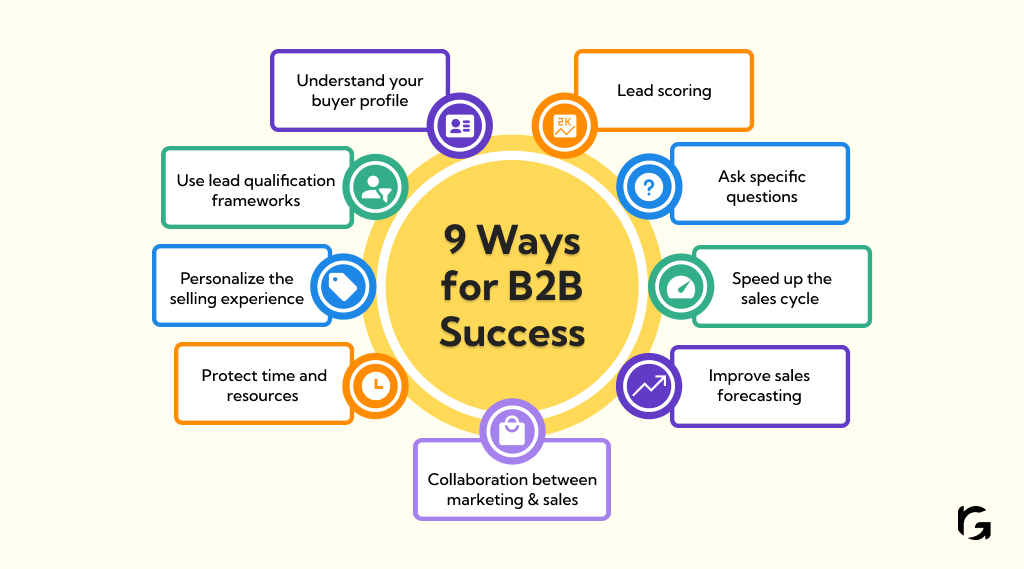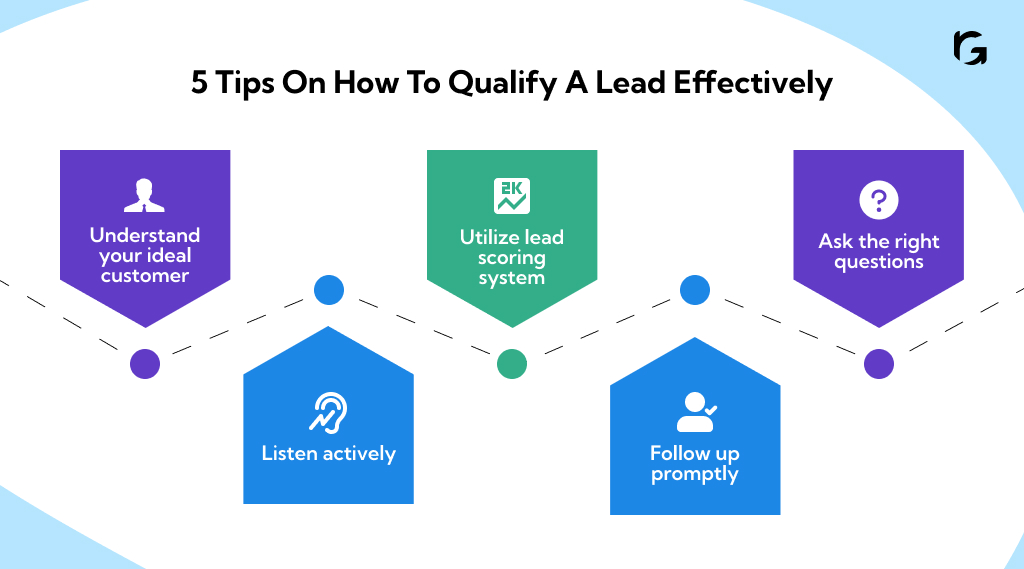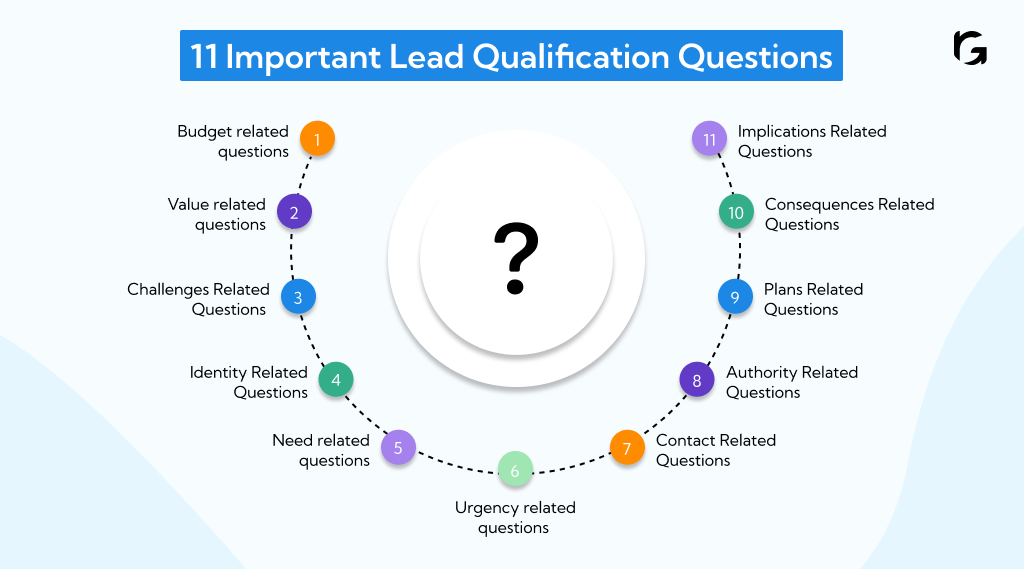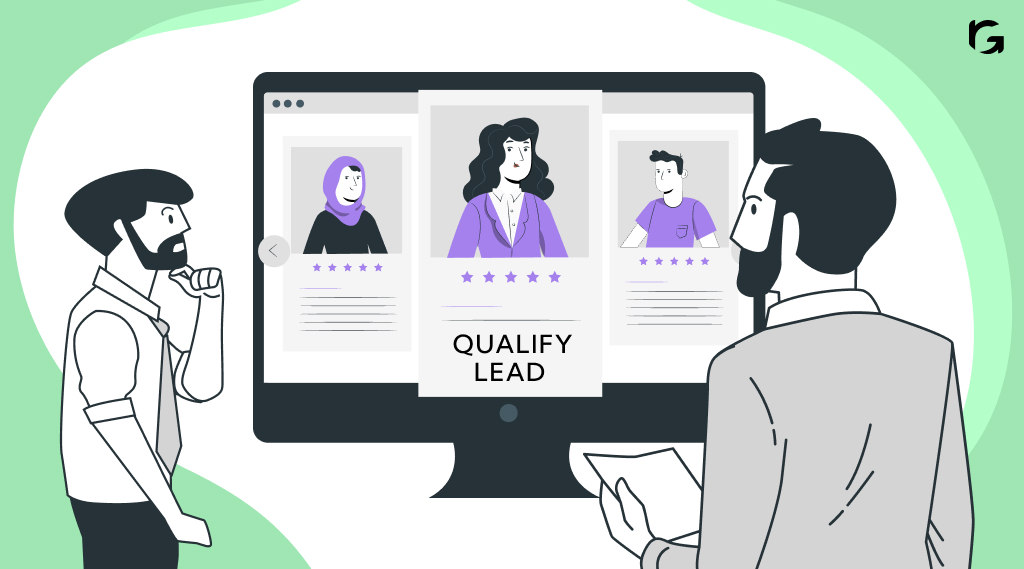Lead qualification is an important aspect of business. There are various that might be interested in your business, but it doesn’t mean they are potential buyers.
To save your time, money, and effort it is essential to filter the leads. In this blog, we will help you understand what a sales-qualified lead is and how to qualify a lead.
So, let’s get started!
How to qualify lead?
To qualify leads effectively, you can follow a structured approach that involves several key steps and frameworks. Here are some steps on how to qualify lead:

- Understand your buyer profile
- Lead scoring
- Use lead qualification frameworks
- Ask specific questions
- Personalize the selling experience
- Speed up the sales cycle
- Collaboration between marketing and sales
- Protect time and resources
- Improve sales forecasting
1. Understand your buyer profile
Begin by creating or reviewing your ideal customer profile to align your lead qualification process with your target audience.
2. Lead scoring
Implement lead scoring to compare and rank qualified leads based on demographic and engagement data, usually on a scale of 0 to 100.
3. Use lead qualification frameworks
Consider frameworks like BANT, CHAMP, MEDDIC, or GPCTBA/C&I to guide your lead qualification process. These frameworks help assess factors like budget, authority, challenges, and timelines to determine lead readiness.
4. Ask specific questions
Engage leads with questions like their biggest priorities, timelines, challenges, and decision-making processes to gather relevant information for qualification.
5. Personalize the selling experience
Customize your value proposition and sales pitches to match the needs and interests of qualified leads, making interactions more relevant and engaging.
6. Speed up the sales cycle
Lead qualification helps you engage with SQLs at the right time and in the right way to accelerate the sales process.
7. Collaboration between marketing and sales
Define ideal customer criteria and lead scoring together to enhance lead quality and improve conversion rates by aligning marketing and sales efforts.
8. Protect time and resources
Avoid wasting resources on poor-fit leads by focusing on those with the highest potential value and lowest acquisition cost.
9. Improve sales forecasting
Consistently qualifying leads ensures a steady flow through the sales pipeline, leading to more accurate sales forecasting and improved business outcomes.
By incorporating these steps and frameworks into your lead qualification process, you can effectively identify and prioritize prospects with the highest potential to become customers, ultimately boosting your sales efficiency and conversion rates.
What is a sales-qualified lead?
A sales-qualified lead (SQL) is a prospect that has been identified by the sales team as being qualified for sales outreach. These leads have met predefined criteria such as having a need for the product or service, an allocated budget, authority to make the purchase, and a timeline that aligns with the company’s purchase cycle. Frameworks like BANT (Budget, Authority, Need, Timing) or lead scoring models are commonly used to qualify leads as sales-ready.
Why is lead qualification important?
Lead qualification is important because it enables businesses to focus their resources and efforts on leads that are most likely to convert into customers, saving time and money by prioritizing high-value prospects.
By identifying and nurturing leads that align with the ideal customer profile, companies can improve conversion rates, enhance productivity, streamline the sales process, and ultimately boost their bottom line through more efficient and effective sales outcomes.
Where does lead qualification fall in the overall sales process?
Lead qualification falls within the early stages of the sales process, specifically at the top of the sales funnel.
It is a crucial step that precedes sales engagement and involves assessing and predicting the likelihood that a sales prospect will become a customer. By qualifying leads effectively, businesses can prioritize their resources and focus on prospects with the highest potential to convert, ultimately improving sales efficiency and increasing conversion rates
What does a lead qualification process actually look like?
The lead qualification process involves several key steps that help businesses identify prospects with the highest potential to become customers:
1. Development of ideal customer profile (ICP): Define your target customers, industry, pain points, authority, and spending abilities to compare leads against this profile
2. Implementation of lead qualification framework: Use frameworks like BAN or GPCTBA/C&I to set criteria for qualifying leads, often through discovery calls and qualifying questions
3. Movement of qualified leads down the sales funnel: Progress qualified leads to the next stage of the sales process by crafting proposals, handling objections, and scheduling follow-ups
4. Closure of sale: Once leads are qualified, they reach a decision point where they are marked as “closed won” or “closed lost” by the sales team
5. Nurturing unqualified leads: Unqualified leads can be included in a nurture flow for potential future qualification
6. Benefits of lead qualification: Lead qualification saves time, money, and energy by focusing efforts on prospects likely to convert, improving sales efficiency and ROI
7. Objective and subjective components: Objective qualification involves gathering specific data like company size or revenue, while subjective qualification assesses a prospect’s likelihood to buy based on their stage in the buying process
8. Lead scoring: Lead scoring, a subset of lead qualification, assigns scores to qualified leads based on demographic and engagement data, aiding in prioritizing leads for conversion
9. Disqualifying leads: It’s essential to disqualify leads that don’t fit the ideal customer profile to focus resources on more promising prospects
By following these steps, businesses can effectively identify, prioritize, and nurture leads with the highest potential to convert into customers, ultimately enhancing sales outcomes and maximizing resources.
5 Tips on how to qualify a lead effectively

Here are 5 tips on how to qualify leads effectively in a concise and direct manner:
- Understand your ideal customer
- Utilize lead scoring system
- Ask the right questions
- Listen actively
- Follow up promptly
1. Understand your ideal customer
Develop a clear understanding of your ideal customer profile, including demographics, pain points, and buying habits, to guide lead qualification
2. Utilize lead scoring system
Implement a lead scoring system to evaluate leads based on specific criteria like job title, company size, and engagement level, enabling you to prioritize efforts on high-potential leads
3. Ask the right questions
During the qualification process, ask relevant questions to understand the lead’s needs, pain points, and decision-making process, helping tailor your sales pitch effectively
4. Listen actively
Practice active listening to build trust with leads, gather valuable information, and increase the chances of closing deals by addressing their concerns effectively
5. Follow up promptly
After qualifying a lead, ensure timely follow-ups via email, phone calls, or personal visits to keep your business top of mind and enhance the chances of closing the deal
11 Important lead qualification questions to ask your leads before qualifying them

Here are 11 lead qualification questions and why they are important:
- Budget related questions
- Value related questions
- Challenges related questions
- Identity related questions
- Need related questions
- Urgency related questions
- Contact related questions
- Authority related questions
- Plan related questions
- Consequences related questions
- Implications related questions
1. Budget related questions
Questions like:
- What is the budget you have available to address this issue?
- How does your company’s purchase approval procedure operate?
- Do you believe investment would be worthwhile to achieve the desired results?
These are some of the budget-related questions. These questions help in identifying whether the customer can afford your product or service or not:
Importance:
Understanding a lead’s budget helps determine if they can afford your product or service, ensuring alignment between their financial capabilities and your pricing
2. Value related questions
Not everyone will appreciate the value of your product or service. Therefore it is essential to make your lead realize the value your brand carries. You can ask questions like:
- To what extent does our product or service meet your needs?
- How much value may this bundle or item add to your business?
- Which features do you think are most important?
to help them see what you bring to the table and why you are unique.
Importance
Inquiring about the value a lead sees in your offering helps gauge their interest and alignment with your product or service, guiding personalized sales pitches and solutions.
3. Challenges related questions
Every consumer has obstacles while buying a product or service. If you want to master the art of conversion then you should handle their objections firsthand.
You can ask questions like:
- What is the biggest obstacle you are now facing?
- What would prevent your business from collaborating with us in the future?
to solve their problem and help them in better decision-making.
Importance
Asking about the challenges a lead faces provides insights into their pain points and obstacles, allowing you to tailor your pitch to address their specific needs effectively.
4. Identity related questions
Identifying the identity of the lead is an important aspect of lead qualification. Whether you know about an individual or about a company, it is essential to know who is responsible for decision-making and how they are going to make the decision.
You can always ask questions like:
- How would you use this solution on a daily basis?
- Who bears accountability for (the service your business offers)?
To know whether the prospect is worth your time or not?
Importance
Inquiring about the lead’s identity helps personalize interactions, build rapport, and understand their role in the decision-making process within their organization
5. Need related questions
It is always easy to sell when you know the exact needs of the customer. You can personalize the pitch according to the needs of the buyer. Questions like:
- Based on the goods and services your business provides, what outcomes are you hoping for?
- What aspects of our goods or services catch your attention the most?
Helps in identifying the pain point of the customer and what the lead wants.
Importance
Understanding the lead’s needs helps align your offering with their requirements, ensuring that your product or service can effectively address their pain points and goals.
6. Urgency related questions
It is always a great idea to add urgency or create FOMO in the mind of your lead so that they can make quick decisions. Questions like:
- When will you decide what to do?
- What inspired you to take action at this time?
Motivates the consumer to take immediate action.
Importance
Inquiring about the lead’s sense of urgency helps prioritize leads based on their timeline for making a purchase, guiding sales efforts toward prospects ready to act quickly
7. Contact related questions
Contact-related questions can help in building a connection with the lead.
You can make connections by asking these questions:
- How do you want to stay in touch?
- Would you be able to arrange a meeting for (certain date)?
Importance
Gathering contact information is crucial for maintaining communication and nurturing leads effectively throughout the sales process, ensuring a seamless and personalized experience
8. Authority related questions
The authority-related question helps in engaging with decision-makers. You can ask these questions for the identification of decision-makers.
- Who are the main players in this initiative or project?
- For this segment of the company, who makes the financial decisions?
Importance
Identifying the decision-makers within the lead’s organization helps streamline the sales process by targeting individuals with the power to make purchasing decisions
9. Plan related questions
Plan-related lead qualifying questions could be:
- How does your current timeline align with implementing a solution like ours?
This question helps assess the prospect’s readiness and commitment to making a decision within a specific timeframe, allowing you to tailor your approach accordingly and prioritize leads based on their urgency and timeline for implementation.
Importance
Understanding the lead’s plans and strategies for achieving their goals provides valuable insights into their priorities and helps tailor your solution to meet their specific needs
10. Consequences related question
A consequences-related question in lead qualifying could be:
- What will be the consequences if you don’t achieve your goals? 5
This question aims to uncover the potential impact of not addressing the prospect’s needs or challenges, highlighting the importance of understanding the repercussions of inaction in the decision-making process.
Importance
Inquiring about the consequences of not achieving their goals helps emphasize the value of your offering by highlighting the potential benefits and opportunities it can provide
11. Implications related question
An implication-related lead qualifying question could be:
- What negative consequences do you foresee if you do not address this challenge promptly?
This question aims to uncover the potential negative outcomes or impacts of inaction, helping to emphasize the urgency and importance of addressing the prospect’s challenges or needs.
Importance
Understanding the implications of achieving their goals helps position your product or service as a valuable solution that can drive positive outcomes for the lead’s organization, enhancing the perceived value of your offering
By asking these lead qualification questions, businesses can gather essential information to assess lead fit, tailor their sales approach, and increase the likelihood of converting leads into customers effectively.
A classic lead qualification example for any b2b saas business
Example 1: Rule-based lead qualification
In a B2B SaaS business, a rule-based lead qualification process can be implemented to efficiently assess and categorize leads based on specific criteria. This method involves setting rules that automatically qualify or disqualify leads based on predefined conditions.
For instance, if a lead meets certain criteria like attending a product event, having an approved budget, and having a purchase timeframe within a year, they can be automatically classified as a qualified lead. This approach streamlines the lead qualification process by automating the evaluation based on objective parameters, ensuring that only leads meeting specific requirements progress further in the sales pipeline
Example 2: Internal sales group qualification
Another effective lead qualification method in B2B SaaS involves leveraging an internal sales group to evaluate and qualify leads. In this approach, salespeople within the organization assess the quality of information received for each lead generated. They determine the lead’s potential by analyzing factors such as the completeness of details, relevance to the target audience, and alignment with the company’s ideal customer profile.
If a lead is deemed promising and worth pursuing, salespeople can convert it into an opportunity, establish contact, schedule meetings, and progress the lead through the sales pipeline. This method allows for a personalized and hands-on approach to lead qualification, ensuring that only high-quality leads with genuine potential are pursued further for conversion into customers
Internal link: Bant marketing
Internal linking in BANT marketing refers to the practice of strategically connecting different components or stages within the BANT framework to ensure a cohesive and effective lead qualification process. This approach involves creating logical connections between the elements of Budget, Authority, Need, and Timeline to streamline the qualification process and guide sales representatives toward successful lead conversions.
Budget to need: Linking the budget and need aspects in BANT marketing involves understanding how a prospect’s financial resources align with their specific challenges or pain points. By establishing a connection between the prospect’s budget constraints and the urgency of addressing their needs, sales reps can tailor their solutions to fit within the prospect’s financial capabilities, increasing the likelihood of a successful sale.
Authority to timeline: Internal linking between authority and timeline focuses on identifying key decision-makers within the prospect’s organization and understanding their timeframe for making purchasing decisions. By establishing a clear connection between the level of authority and the urgency of the prospect’s timeline, sales reps can prioritize engagements with individuals who have the power to move the buying process forward swiftly, ensuring efficient decision-making and closing deals promptly.
Need for authority: Connecting the prospect’s needs with the level of authority within their organization is crucial in BANT marketing. By aligning the prospect’s challenges or pain points with the decision-making power of key stakeholders, sales reps can effectively navigate the buying process and engage with individuals who have the authority to address the prospect’s needs. This internal linking ensures that sales efforts are directed toward decision-makers capable of evaluating and approving solutions that address the prospect’s specific requirements.
Internal linking in BANT marketing enhances the lead qualification process by establishing logical relationships between different criteria, and guiding sales reps toward a comprehensive understanding of prospects’ needs, capabilities, and timelines. By strategically connecting the elements of Budget, Authority, Need, and Timeline, sales teams can effectively qualify leads, tailor their sales approach, and increase the likelihood of successful conversions in B2B marketing scenarios.
5 Lead qualification tools
Here are 5 lead qualification tools and their unique features based on the provided sources:
- Pathmonk
- ProProfs Survey Maker
- HubSpot
- Unbounce
- Salesforce CRM
1. Pathmonk
Unique Feature: Pathmonk offers AI-powered lead qualification capabilities that provide valuable insights about website visitors’ behavior, allowing for immediate lead qualification or disqualification based on predefined criteria. This tool goes beyond basic chatbots by deploying full qualification logic on websites, streamlining the lead qualification process for marketers and sales development representatives (SDRs)
2. ProProfs Survey Maker
Unique Feature: Proprofs survey maker enables businesses to directly engage with potential customers by gathering feedback and insights through surveys. By understanding customer preferences and needs, businesses can effectively qualify leads based on their responses, ensuring that only relevant and interested leads are pursued further
3. HubSpot
Unique Feature: Hubspot is a comprehensive marketing automation tool that includes lead qualification features. It offers a wide range of functionalities to automate lead qualification processes, nurture leads, and track their progress through the sales funnel. HubSpot’s integrated platform allows businesses to streamline lead qualification and improve lead conversion rates
4. Unbounce
Unique Feature: Unbounce is a tool that focuses on creating high-converting landing pages to capture leads effectively. By optimizing landing page design and content, Unbounce helps businesses attract quality leads and improve lead qualification rates. Its features enable businesses to enhance lead-generation efforts and drive conversions through well-designed landing pages.
5. Salesforce CRM
Unique Feature: Salesforce CRM is a widely used customer relationship management tool that offers lead qualification functionalities. It provides a centralized platform for managing leads, tracking interactions, and qualifying prospects based on predefined criteria. Salesforce CRM’s robust features enable businesses to streamline lead qualification processes, improve lead management, and enhance overall sales performance.
Conclusion
Leveraging frameworks like BANT or GPCTBA/C&I, understanding the nuances of the ideal customer profile, and using advanced lead qualification tools can significantly enhance the agency’s sales efforts.
Prioritizing personalized interactions, active listening, and timely follow-ups with qualified leads can further solidify relationships and increase the likelihood of successful conversions. Ultimately, a strategic and data-driven approach to lead qualification not only optimizes resource allocation but also promotes long-term customer relationships, driving sustainable growth and profitability for B2B SaaS agencies. Get in touch today to scale your b2b business.



